The Bulldozer Review: AMD FX-8150 Tested
by Anand Lal Shimpi on October 12, 2011 1:27 AM ESTThe Test
To keep the review length manageable we're presenting a subset of our results here. For all benchmark results and even more comparisons be sure to use our performance comparison tool: Bench.
| Motherboard: |
ASUS P8Z68-V Pro (Intel Z68) ASUS Crosshair V Formula (AMD 990FX) |
| Hard Disk: |
Intel X25-M SSD (80GB) Crucial RealSSD C300 |
| Memory: | 2 x 4GB G.Skill Ripjaws X DDR3-1600 9-9-9-20 |
| Video Card: | ATI Radeon HD 5870 (Windows 7) |
| Video Drivers: | AMD Catalyst 11.10 Beta (Windows 7) |
| Desktop Resolution: | 1920 x 1200 |
| OS: | Windows 7 x64 |
Windows 7 Application Performance
3dsmax 9
Today's desktop processors are more than fast enough to do professional level 3D rendering at home. To look at performance under 3dsmax we ran the SPECapc 3dsmax 8 benchmark (only the CPU rendering tests) under 3dsmax 9 SP1. The results reported are the rendering composite scores.

As our first heavily threaded, predominantly FP workload we see the FX-8150 come out swinging. A tangible upgrade from the Phenom II X6, the 8150 is hot on the heelds of the Core i5 2400, however it is unable to compete with the 2500K and 2600K.
Cinebench R10 & 11.5
Created by the Cinema 4D folks we have Cinebench, a popular 3D rendering benchmark that gives us both single and multi-threaded 3D rendering results.
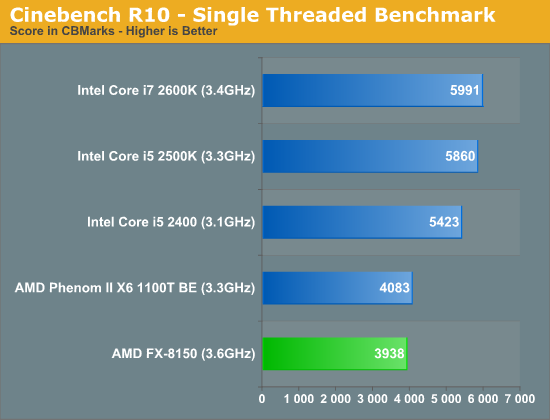
As I alluded to earlier, single threaded performance is going to be a bit of a disappointment with Bulldozer and here you get the first dose of reality. Even considering its clock speed and Turbo Core advantage, the FX-8150 is slower than the Phenom II X6 1100T. Intel's Core i5 2500K delivers nearly 50% better single threaded performance here than the FX-8150.
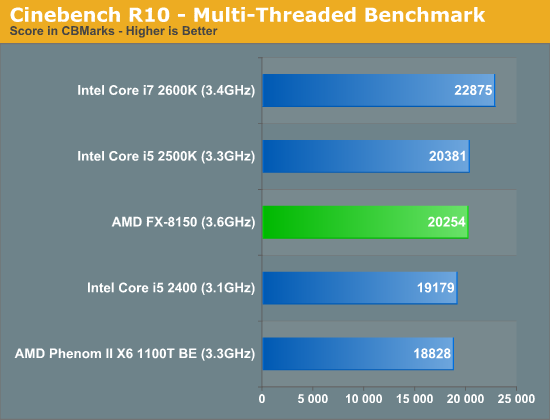
Crank up the threads and the FX-8150 shines, finally tying the 2500K at a comparable price point.
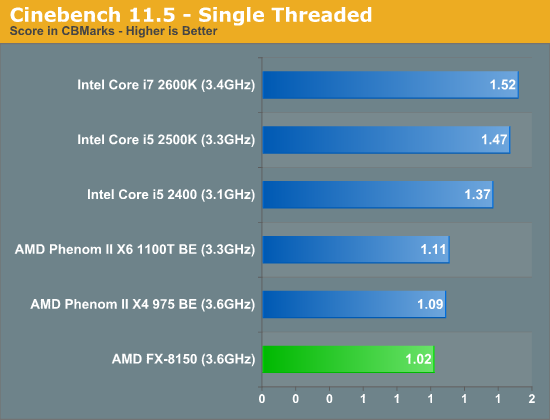
Even with more modern workloads, the FX-8150 isn't able to compete in single threaded speed. Here the 2500K is 44% faster.
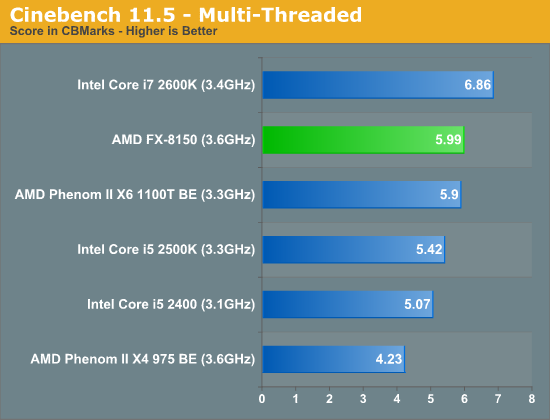
Modern multithreaded workloads however do quite well on Bulldozer. The gains over the old Phenom II X6 1100T are unfortunately not as large as we would expect them to be.
7-Zip Benchmark
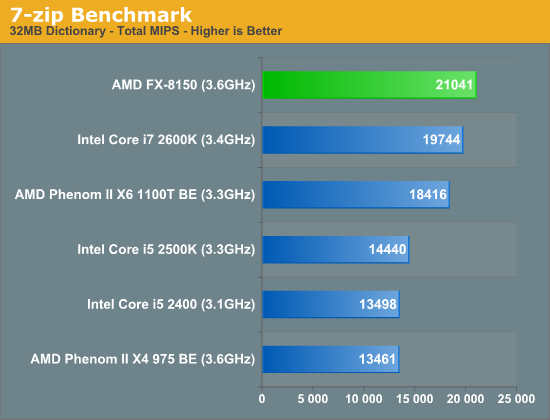
Heavily threaded workloads obviously do well on the FX series parts, here in our 7-zip test the FX-8150 is actually faster than Intel's fastest Sandy Bridge.
PAR2 Benchmark
Par2 is an application used for reconstructing downloaded archives. It can generate parity data from a given archive and later use it to recover the archive
Chuchusoft took the source code of par2cmdline 0.4 and parallelized it using Intel’s Threading Building Blocks 2.1. The result is a version of par2cmdline that can spawn multiple threads to repair par2 archives. For this test we took a 708MB archive, corrupted nearly 60MB of it, and used the multithreaded par2cmdline to recover it. The scores reported are the repair and recover time in seconds.
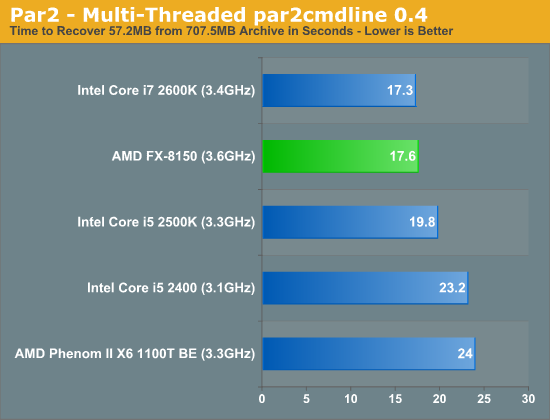
Once again, throw more threads at the processor and the FX-8150 can outperform the Core i5 2500K.
TrueCrypt Benchmark
TrueCrypt is a very popular encryption package that offers full AES-NI support. The application also features a built-in encryption benchmark that we can use to measure CPU performance with:
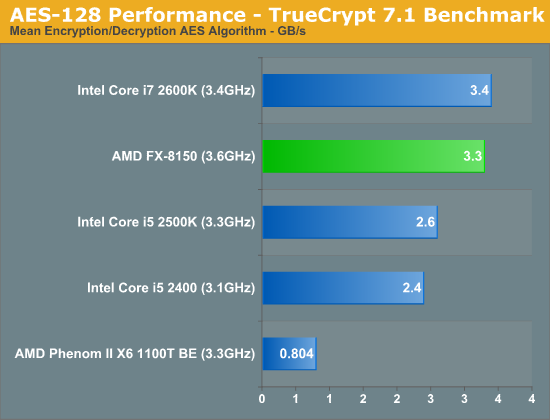
Bulldozer adds AES-NI acceleration, a feature that wasn't present in the Phenom II X6. As a result the FX-8150 is among the fastest at real time AES encryption/decryption, second only to the 2600K. Intel's artificial segmentation using Hyper Threading comes back to haunt it here as the 2500K is significantly slower than the 8-threaded beast.
x264 HD 3.03 Benchmark
Graysky's x264 HD test uses x264 to encode a 4Mbps 720p MPEG-2 source. The focus here is on quality rather than speed, thus the benchmark uses a 2-pass encode and reports the average frame rate in each pass.
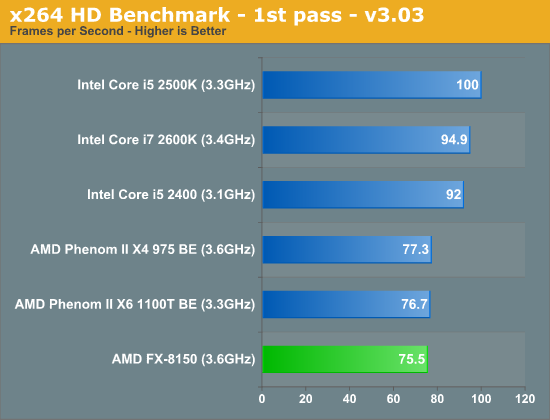
As I mentioned earlier, the first pass of our x264 HD benchmark is a lightly threaded task. As such, the FX-8150 doesn't do very well here. Even the old Phenom II is able to inch ahead of AMD's latest. And Sandy Bridge obviously does very well.

The second pass is more thread heavy, allowing the FX-8150 to flex its muscle and effectively tie the 2600K for first place.
AMD also sent along a couple of x264 binaries that were compiled with AVX and AMD XOP instruction flags. We ran both binaries through our x264 test, let's first look at what enabling AVX does to performance:
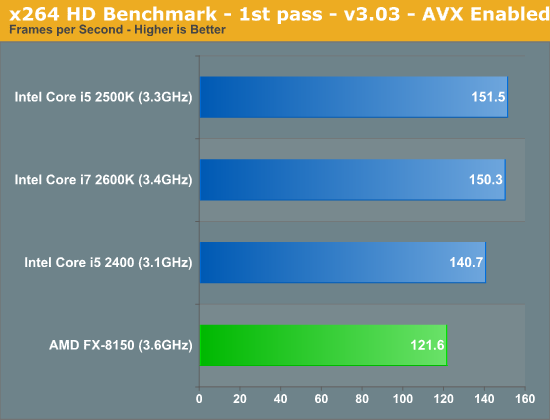
Everyone gets faster here, but Intel continues to hold onto a significant performance lead in lightly threaded workloads.
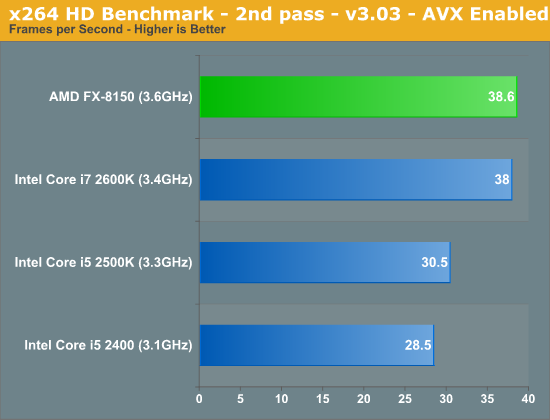
The standings don't change too much in the second pass, the frame rates are simply higher across the board. The FX-8150 is an x86 transcoding beast though, roughly equalling Intel's Core i7 2600K. Although not depicted here, the performance using the AMD XOP codepath was virtually identical to the AVX results.
Adobe Photoshop CS4
To measure performance under Photoshop CS4 we turn to the Retouch Artists’ Speed Test. The test does basic photo editing; there are a couple of color space conversions, many layer creations, color curve adjustment, image and canvas size adjustment, unsharp mask, and finally a gaussian blur performed on the entire image.
The whole process is timed and thanks to the use of Intel's X25-M SSD as our test bed hard drive, performance is far more predictable than back when we used to test on mechanical disks.
Time is reported in seconds and the lower numbers mean better performance. The test is multithreaded and can hit all four cores in a quad-core machine.
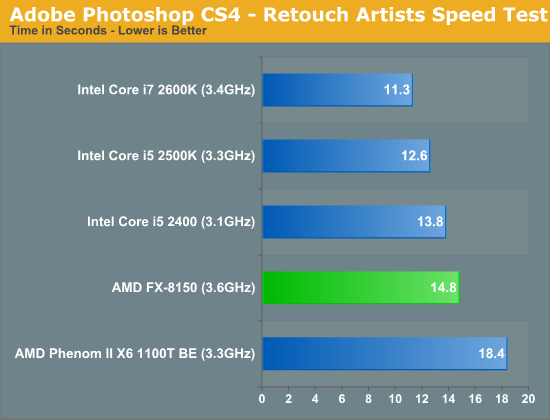
Photoshop performance improves tangibly over the Phenom II X6, unfortunately it's not enough to hang with the enthusiast Sandy Bridge parts.
Compile Chromium Test
You guys asked for it and finally I have something I feel is a good software build test. Using Visual Studio 2008 I'm compiling Chromium. It's a pretty huge project that takes over forty minutes to compile from the command line on a dual-core CPU. But the results are repeatable and the compile process will easily stress more than 8 threads on a CPU so it works for me.
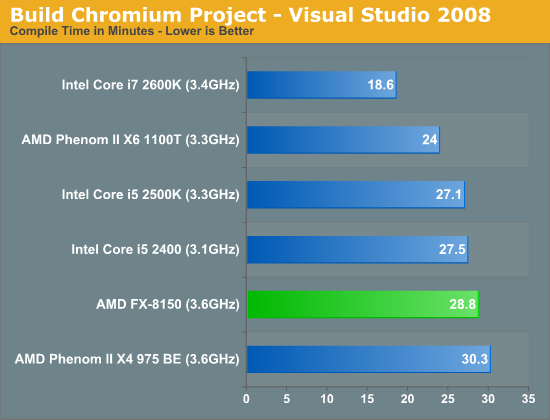
Our compiler test has traditionally favored heavily threaded architectures, but here we found the Phenom II X6 1100T to offer a tangible performance advantage over Bulldozer. While AMD is certainly competitive here, this is an example of one of those situations where AMD's architectural tradeoffs simply don't pay off—not without additional clock speed that is.
Excel Monte Carlo

Our final application test is another win for AMD over the Core i5 2500K. The victory is entirely a result of Intel's Hyper Threading restrictions though, the eight-thread 2600K is able to easily outperform Bulldozer. Either way, AMD delivers better performance here for less money.










430 Comments
View All Comments
Pipperox - Saturday, October 15, 2011 - link
With a 40-50% gain Bulldozer would be even ahead of Ivy Bridge.. and what comes next.Or are we still talking about SuperPI?
Or games run at 640x480 lowest quality settings?
The fact is, almost all single threaded applications are old and they run already super fast on ANY cpu and the difference can be seen only in benchmarks.
All recent performance demanding applications are properly multithreaded, and Bulldozer there is competitive with i5 2500 and occasionally with i7 2600 (and with a 10% boost Bulldozer would be competitive with i7 2600).
And this will become more and more the standard one year from now.
Sure Bulldozer has not met the enthusiasts' expectations, it doesn't perform as people would expect an "octacore" (but it's not, it's just a quad with a different form of hyperthreading and "clever" marketing) and it doesn't deserve the FX moniker.
But still it's the most competitive CPU AMD has launched in years, perhaps with the exception of Zacate.
nirmv - Saturday, October 15, 2011 - link
Not all applications are heaviliy multi-threaded, there is still need to improve single thread performance.And even for those few loads that are competitive in performance, they do it with twice the power draw.
See here from xbitlabs review :
http://www.xbitlabs.com/images/cpu/amd-fx-8150/pow...
Pipperox - Sunday, October 16, 2011 - link
But increasing single threaded performance has a cost, on die space and circuit complexity.Bulldozer has a huge die just because it has enormous caches (8MB L2 vs 1Mb on SandyBridge) which probably will turn useful on server workloads (but that's just a guess).
By looking at the die shot, you'd get a 40% die area reduction with "normal" caches.
So AMD engineers decided to drop single threaded performance improvements in favor of higher multithreaded scalability and higher clock speed scalability.
We'll see if in the long run this will pay off.
I agree power consumption doesn't look good in comparison with Intel, but it does look good in comparison to Thuban.
This is the first released silicon of Bulldozer.. i expect power consumption to improve with newer steppings and silicon process tuning.
That being said, Intel has the best silicon process in the whole industry.
AMD can't compete with that.
But i'd guess that at lower clock speeds (like in server), AMD's power consumption will improve a lot.
Looks like with the FX AMD tried to push their current silicon to the maximum which they could (within the 125W TDP which is sort of an industry standard).
LiveandEnjoyLife - Friday, October 14, 2011 - link
Some people are missing the point. At this stage in the game, processor speed is a moot point beyond benchmarks. AMD and Intel make very fast CPUs in relation to what gamers and every day users use them for. Intel CPUs are blazing fast and AMD CPUs are fast. The average Joe does need more than a dual-core CPU. If you were going to actually do something that would require heavy multi-threading, then it comes down to the efficiency the app to make use of the cores and the ability to use hyperthreading. If you wanted the most performance for a mult-threaded application, you would pick more physical cores over virtual cores. So for most of use it comes down to bang for buck.8 cores is better than 2, 4, or 6 for true multi-threaded capable applications.
For speed tests Intel wins hands down.
If you were sitting next to someone playing a game and all things were the same except CPU, you would not be able to tell which machine is running what CPU. However you would notice if one costs significantly more than the other.
That is my 4 cents.
7Enigma - Friday, October 14, 2011 - link
Hi Anand,Great review but there is a text error when referring to pass one vs. pass two of the benchmark mentioned in the Subject line. You said:
"The standings don't change too much in the second pass, the frame rates are simply higher across the board. The FX-8150 is an x86 transcoding beast though, roughly equalling Intel's Core i7 2600K. Although not depicted here, the performance using the AMD XOP codepath was virtually identical to the AVX results."
But the graph clearly shows a complete flip-flop from first pass to second pass. When I look closely it appears you ordered the text and graphs differently and were referring to if you had the non-AVX and AVX-enabled graphs next to each other instead of in separate sections. Basically the text and graphs don't match up.
HTH
Iketh - Friday, October 14, 2011 - link
You're an utter retard. The reason they're sold out is newegg advertised these nicely all over their site, including the front page, with "World's first 8-core desktop processor."There are plenty of reasons to purchase these processors aside from their performance and that's ok. But the majority bought them thinking they're gonna "rock", and those are the ones "showing intelligence." Same goes to you for thinking the majority is well-informed/intelligent.
What's even worse, the 8-core version for sale is the 3.1ghz, not the 3.6 tested in this review. I'm seriously LOL'ing...
How many did Newegg have in stock anyhow? Wouldn't that figure matter regarding your ignorant comment?
rcrossw - Friday, October 14, 2011 - link
I have used AMD products for years. I use Intel at work. So to me there is no real difference between the two for what Business and the Average Computer user want or expect.Does it run, does it do the work I require of it, and do my programs and Network Access
work well and are reliable?
Intel indeed has incredible Processors, fast and reliable, and in the high end - expensive.
AMD is Low and Mid range - with processors that the average person can afford. Who is the most innovative - both. Today Intel has been , now I think the user needs to give this New X86-64 Architecture a chance.
I have a Asus M5A99x EVO with an FX6100 installed. The only problem I have had is having to upgrade the BIOS to accept the new Processor. So far I have had the Processor to 4.2 Ghz. Though AIDA 64 caused a BOD on one test. At 3.8 Ghz runs like a champ. Stil
working back to as close as I can get to 4.2 on Air.
After three years I have retired my old Phenon II Tri Core 720 for this, and it works for me.
I am not an extreme gamer, etc. But test it your self, before being too overly critical.
Does it work for me.
As an aside, next a SSD for faster response.
For those interested:
Asus M5A99x MB BIOS 0810 ( Newest)
AMD FX 6100 at 3.8 ghz
Corsair Vengeance 1600 - 16 gigs
HIS Radeon HD 6850
Windows 7 Ulimate 64
HPLP2475W Monitor at 1920x1200 DP
WD 500 SATA
WD 1001 SATA
LG H20L BD-R
Plextor DVDR
Enermax 620 Liberty PS - I know old but works.
Thanks
davbran - Saturday, October 15, 2011 - link
I have been having a hard time writing a comment on this topic without drawing fire from trolls.This review is hogwash without more information.
If the hardware is the same on all test machines, apart from the CPUs, then there is no wonder the performance was so bad. 6 Cores are going to utilize, and I am just pulling a number out of my ... hat, 4gb of RAM more efficiently than an 8 core using simple kitchen math. No need to break out the slide rules. It's a known fact, to most, that the big bottleneck in the multicore/multiprocessor world is memory. Mind you that's if we are factoring in that all the code that was used for testing purposes was written with multi-threading in mind.
You just can't compare apples to bananas in this manner.
silverblue - Saturday, October 15, 2011 - link
Each to their own. I thought it was a pretty good review, and Anand certainly held back from slating AMD to hell.Iketh - Sunday, October 16, 2011 - link
LOLLLLL